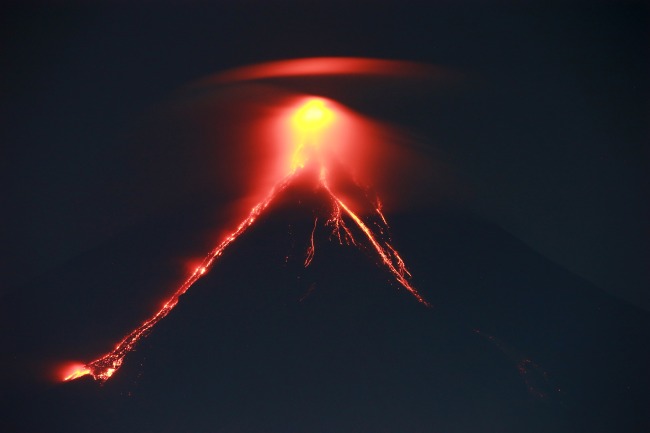MANILA, Philippines -- Glowing-red lava spurted in a fountain and flowed down the Philippines' most active volcano on Tuesday in a stunning display of its fury that has sent more than 34,000 villagers fleeing to safety and prompted police to set up checkpoints to stop tourists from getting too close.
The Philippine Institute of Volcanology and Seismology said the lava flowed as much as 2 kilometers (1.2 miles) from the often cloud-shrouded crater of Mount Mayon, while ash fell on several villages in northeastern Albay province.
Officials strongly advised people not to venture into a danger zone about 6 to 7 kilometers (3.7 to 4.3 miles) around Mayon, including residents who want to check their homes, farms and animals, and tourists seeking a closer view.
"They say it's beauty juxtaposed with danger," Office of Civil Defense regional director Claudio Yucot said.
 |
This photo taken on January 15, 2018 shows lava cascading the slopes of Mayon volcano as it erupts, as seen from Legazpi City in Albay province south of Manila. Spectacular lava "fireworks" shooting from its crater are drawing tourists to the Philippines' most active volcano, authorities said as scientists warned of a potential dangerous eruption within days. (AFP Photo) |
At least 34,038 people have been displaced by Mayon's eruption since the weekend from two cities and six towns, many of whom took shelter in schools turned into evacuation centers, Jukes Nunez, an Albay provincial disaster response officer, said by telephone. Others took refuge in the homes of relatives.
Albay officials declared a state of calamity in the province of more than a million people to allow more rapid disbursement of disaster funds, Nunez said.
"We have witnessed lava fountaining yesterday, that's why we have additional families who evacuated due to the threat," said Romina Marasigan, spokeswoman of the government's main disaster-response agency.
Renato Solidum, who heads the volcanology institute, said the flows cascading down the volcano were not generated by an explosion from the crater with superheated lava, molten rocks and steam, but were caused by lava fragments breaking off from the lava flow and crashing on the lower slopes.
Scientists have not yet detected enough volcanic earthquakes of the type that would prompt them to raise the alert level to four on a scale of five, which would indicate an explosive eruption may be imminent, Solidum said. Emergency response officials previously said they may have to undertake forced evacuations if the alert is raised to four.
In a bid to discourage villagers who insist on returning to the danger zones to check on their farm animals, officials planned to set up evacuation areas for animals, including water buffaloes, cows, pigs and poultry, Yucot said.
Temporary school sites were also being considered to ease the disruption to education after school buildings were turned into emergency shelters, he said.
Mayon is in coconut-growing Albay province, about 340 kilometers (210 miles) southeast of Manila. With its near-perfect cone, it is popular with climbers and tourists but has erupted about 50 times in the last 500 years, sometimes violently.
In 2013, an ash eruption killed five climbers who had ventured near the summit despite warnings. Mayon's first recorded eruption was in 1616 and the most destructive, in 1814, killed 1,200 people and buried the town of Cagsawa in volcanic mud.
The Philippines lies in the so-called "Ring of Fire," a line of seismic faults surrounding the Pacific Ocean where earthquakes and volcanic activity are common.
In 1991, Mount Pinatubo in the northern Philippines exploded in one of the biggest volcanic eruptions of the 20th century, killing about 800 people. (AP)







![[Today’s K-pop] Blackpink’s Jennie, Lisa invited to Coachella as solo acts](http://res.heraldm.com/phpwas/restmb_idxmake.php?idx=644&simg=/content/image/2024/11/21/20241121050099_0.jpg)
